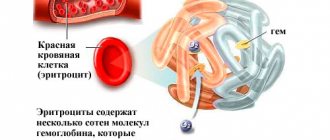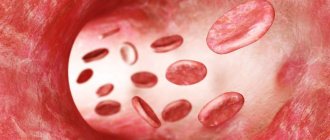What is it used for?
This indicator is one of the most constant in blood tests. In this regard, it is used to identify errors during laboratory tests. The MCHC red blood cell index is used in the following cases:
- when assessing the effectiveness of anemia therapy;
- in the differential diagnosis of anemia;
- when diagnosing hypochromia.
Signs of iron deficiency anemia
Iron deficiency anemia is a common pathology in our time. It is caused by insufficient intake of iron from food or its difficult absorption in the gastrointestinal tract, and may also be associated with some chronic diseases and blood loss. Characterized by a decreased level of red blood cells, it occurs due to severe bleeding, increased destruction of red blood cells or impaired formation of blood cells. Anemia is popularly called anemia. To diagnose it, an analysis to determine the level of red blood cells and hemoglobin is usually not enough. The following blood parameters are usually examined, which together give a more complete picture:
- mean red cell hemoglobin concentration (MCHC);
- average hemoglobin content in one red blood cell (MCH);
- red blood cell distribution width (RDW);
- mean erythrocyte volume (MCV);
- color index (CP).
Description of the analysis
Determination of mchc occurs through calculations based on basic data, such as hematocrit, obtained from a complete blood count. This index serves as a highly sensitive test for disruption of hemoglobin generation processes. The main advantage is that it is independent of the average volume of red blood cells.
Essentially mchc reflects the density of filling red blood cells with hemoglobin and is a very stable indicator. Therefore, mchc is often used as an indicator of errors in the operation of laboratory equipment. But do not confuse MCHC with MCV, as these are different indicators.
MCHC increased
The hemoglobin concentration in red blood cells may be increased in the following cases:
- hyperchromic anemia (ovalocytosis, folate deficiency, B12 deficiency, spherocytosis, including congenital);
- water-electrolyte metabolism is impaired;
- may be high in newborns, which is considered normal.
Elevated concentrations of iron-containing protein are quite rare. If MCHC has increased to 380 grams per liter and continues to rise, hemoglobin may begin to crystallize.
The result is obtained using modern hematology analyzers
Most often, a significant increase in MCHC is not associated with any disease, but indicates an error during a laboratory test, since a high concentration of hemoglobin in red blood cells will lead to morphological changes in red cells and their complete destruction. There is only one disease in which this indicator is increased. This is a hereditary pathology - spherocytosis. Refers to hemolytic anemia and is characterized by a defect in the cell membrane of red cells.
In most cases, the following technical errors are the basis for increased MCHM:
- incorrect determination of hematocrit and hemoglobin;
- violation of the conditions for blood collection and storage, which is why partial disintegration of red blood cells occurred.
Preparing for analysis
Direct analyzes for mchc are not done; general analysis data (CCA) are used for calculations. To carry it out, blood is taken from a vein, the amount is up to 3 ml. If certain indicators are present, it is possible to take capillary blood; such an analysis is prescribed for children under 3 years of age, patients with pathologies of the blood coagulation system.
No special preparation is required for a general blood test. Blood sampling is performed in the morning, on an empty stomach, or at any convenient time of the day. The main condition is not to eat for at least 8 hours before the test. You can drink water, but not coffee, tea or sweet drinks.
To increase the reliability of the data obtained, it is recommended to avoid stress, excessive physical and psycho-emotional stress 1-2 days before blood collection. You should avoid drinking alcohol.
MCHC reduced
A reduced MCHC indicates a condition such as hypochromia, that is, the red cells are not sufficiently saturated with hemoglobin. This condition is associated with pathologies in which the production of iron-containing protein is impaired. Hypochromia can be caused by various types of anemia, hypovitaminosis, lead poisoning, some hereditary congenital diseases, and is also associated with a disorder of iron metabolism in the body. A decrease in the concentration of iron-containing protein in erythrocytes has the following reasons:
- sideroblastic and hypochromic iron deficiency anemia;
- chronic posthemorrhagic anemia;
- hemoglobinopathies, in which hemoglobin synthesis is impaired and some amino acids are replaced in its chains;
- disturbance of water-electrolyte metabolism;
- thalassemia (some types) is a hereditary disease associated with mutations in genes that are responsible for the synthesis of iron-containing protein;
- megaloblastic anemia, in which red cells increase in volume more significantly than they are saturated with iron-containing protein.
When hemoglobin synthesis is impaired, MCHC decreases last. Therefore, a decrease in the concentration of iron-containing protein with normal values of other blood parameters (erythrocyte and hemoglobin content) indicates an erroneous laboratory test result.
MCH norm indicators
The average amount of hemoglobin in one red blood cell varies depending on age and gender. Its average value in a healthy adult is from 27 to 31 picograms (pg). The highest rates are observed in infants under 14 days of age. They can vary from 30 to 37 pg and, as they grow older, gradually decrease and are compared with the norm for adults. Norms for women
| Woman's age, years | Norm MCH per red blood cell (in pg) |
| 16-18 | 26-34 |
| 19-45 | 27-35 |
| 46-60 | 27-34 |
| After 60 | 27-35 |
The norms for men are approximately the same as for women. Minimal deviations are observed. 46-6027-34 After 6027-35
| Man's age, years | Norm MCH per red blood cell (in pg) |
| 16-18 | 27-32,5 |
| 19-45 | 27-34 |
| 46-60 | 27-35 |
| After 60 | 27-34,5 |
Norms for children. It should be noted that these indicators are unstable; they can change within a matter of hours or days.
| Child's age, years | Norm MCH per red blood cell (in pg) |
| 1-4 months | 27-32 |
| 1-3 years | 23-31 |
| 7-15 years | 26-32 |
What does it mean if monocytes are elevated?
In a normal state, the number of monocytes in the blood is as follows (per 1 liter of blood):
- for adults: from 0.04 to 0.08*109 cell units;
- for children: from 0.05 to 1.1 * 109 cell units.
If we talk about the norm in relative terms, then the number of monocytes should be 1% -10% of the total mass of leukocytes. Moreover, for children the optimal range is from 2% to 7%, and for adults – from 1% to 8%. If the concentration is greater than the specified values, this indicates increased monocytes in the blood. This disorder is called monocytosis.
Vitamins, microelements and hemoglobin
The choice of micronutrients and the need to take complexes should be considered from different perspectives:
- Against the background of pathological conditions
In this case, the addition of any multivitamin preparations, except those aimed at treating diseases of the hematopoietic system, must be discussed with the attending physician. Inflated hemoglobin density indicators require special attention, since additional intake of B vitamins will cause a new increase in the index or no decrease in the blood test results.
At the same time, at low levels, taking B vitamins and iron supplements is completely justified, since it is these compounds that help restore values to normal.
- Prevention and prevention of diseases
The choice of micronutrients in this case also requires preliminary discussion with a specialist who will focus exclusively on the results of blood tests. In addition to the erythrocyte index, you will need indicators for leukocytes and platelets - all this data will be reflected in the CBC.
A general study of blood quality, together with a biochemical analysis and results on the presence and concentration of vitamins, is the most informative picture of the state of health. This combination of blood tests, in addition to diagnosing diseases, is widely used in dietetics and pediatrics, and allows one to determine the actual, personal need for micronutrients.
What are monocytes in the blood
Monocytes are a type of leukocyte - white blood cells. These are large formations with large nuclei. They are involved in protecting the body from inflammatory processes. Monocytes can penetrate the walls of blood vessels, leaving the blood and rushing to the site of inflammation. They destroy bacteria, viruses, as well as dead cells of their own body. It turns out that monocytes perform an important sanitary function.
This is especially important during infectious diseases. For example, if a person is sick with the flu, at this moment many cells of the oropharynx and nasal cavity are destroyed. Then monocytes will arrive in large numbers to the appropriate areas and digest the dead parts of the cells. In this case, the tissues will recover faster, which will contribute to overall recovery.
Deciphering the MCH blood test
Increase in MCH
If the MCH exceeds the upper permissible limit, then this indicates the presence of a pathological process in the body. Diagnosis of the underlying disease that provoked this change is carried out after determining the cause. In most cases, a similar jump is observed with hyperchromia. This term refers to a condition characterized by an increase in hemoglobin in red blood cells. As a rule, it develops when a person has some type of anemia. The MCH level in the blood increases under the following conditions:
- Severe leukocytosis.
- Exceeding the norm for the amount of fat.
- Increase in the number of heparins.
- Destruction of red blood cells caused by a number of diseases (malaria, poisoning with certain poisons or chemicals, hemolytic anemia, systemic lupus erythematosus, kidney damage, toxoplasmosis, systemic scleroderma, viral hepatitis B and C).
The reasons for such deviations may be a deficiency of vitamin B12, B9 and the use of certain medications (therefore, it is extremely important to carefully study the side effects indicated in the attached instructions, and also stop using the drug before taking the test). To prevent receiving false information, it is recommended to first consult with a doctor and clarify which medications the patient is currently taking. For example, in women, MSI may be affected by a long and uninterrupted course of contraceptive medications.
Other etiological factors that can cause an increase in MSI are:
- Liver damage (especially hepatitis and cirrhosis)
- Excessive drinking of alcoholic beverages and terminal stages of alcoholism.
- Leukemia.
- Neoplasms (both malignant and benign), localized in the bloodstream and other internal organs.
In addition, high hemoglobin levels are observed in individuals suffering from hyperthyroidism. This is a disease of the endocrine system, characterized by damage to the thyroid gland. Its main symptoms are organ enlargement, exophthalmos, increased physical activity, emotional lability, excessive appetite, weight loss, abnormal activity and accelerated metabolism. Often this pathology is diagnosed in residents of an endemic zone, in which, due to natural conditions, there is a low concentration of iodine.
Decreased MCH
If the interpretation of the MCH blood test showed a decrease in this indicator, then this result indicates the presence of another form of anemia - anemia of the hypochromic type. The most common type of this pathology is iron deficiency anemia, characterized by insufficient absorption of iron.
With a decrease in the relationship between Fe and hemoglobin, a noticeable change in the normal parameters of a clinical blood test occurs. In most cases, this indicates the following diseases:
- A source of inflammation localized in any part of the body.
- Disorder of metabolic processes affecting iron metabolism.
- Hypovitaminosis caused by malnutrition, internal pathologies and other etiologies.
- An intoxication period that arose against the background of long-term lead poisoning.
A decrease in MCH has a strong impact on the normal course of biochemical processes, as a result of which a person’s condition significantly worsens. As a rule, this causes rapid fatigue, weakness, pale skin, dry skin, brittle hair and nails. Often there is a feeling of dumbness in the upper and lower extremities, ulcers in the corners of the mouth and irregular heart rhythm.
Having identified any irregularities in the MCH indicators, you must immediately contact a qualified doctor. Only he, based on the laboratory data obtained, will be able to make an accurate diagnosis and select the most effective treatment method.










